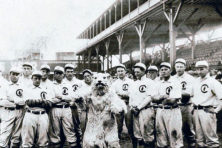Building a Beautiful Garden
- Share
- Tweet
- Pin
- Share

Melinda Myers watches as Debbie Jones of Ellison Bay takes a coleus cutting and then helps her prepare it for rooting. Photo by Gary Jones.
The 32 students who attended The Clearing’s September workshop “Building a Beautiful Garden” were dedicated gardeners, as they were already thinking about next year’s garden while the effects of Northern Door’s summer drought lingered on. But anyone who wields a dusty hoe may find inspiration in the animation, humor, and wisdom of gardening expert Melinda Myers.
While many of those in attendance live in Door County, some traveled from other parts of the state and beyond.
Like a number of the student gardeners, Peggy Moutray “came to get ideas on new cultivars.” Originally from Austin, Texas, she and her husband have retired near Gills Rock and “don’t know much about what grows here.” They have built a new house and “need to know what to be planting.”
Al Corcoran of Edina, Minnesota, has been visiting college friends in Door County for over 50 years, one of whom “alerted me about this workshop.” While he is a life-long gardener, this was his first formal class. He was “interested in information about fall plantings.”
Other students hoped to learn about design, garden maintenance, specialty gardens, pest control, amending soil, year-round color, and propagation. One will be featured on a garden tour next year; another is a Master Gardener needing credits; yet another is a professional landscape gardener.
Melinda Myers is well known to television audiences for her Garden Moment segments, and to serious gardeners because of her columns in Birds & Blooms magazine, her Plant Doctor Milwaukee radio program, Great Lakes Gardener on PBS, and over 20 gardening books, including Can’t Miss Small Space Gardening and Month-by-Month Gardening in Wisconsin.
After listening to each of her students, Myers tailored her presentation to provide the content they wanted. But in addition to being a gardening authority (drawing upon her 32 years of experience that includes a master’s degree in horticulture, arborist certification, employment with the UW – Extension and teaching experience with the Milwaukee Area Technical College), she is also an entertainer. Her Clearing students laughed at her wit throughout the seven-hour workshop.
Myers is not a gardening diva. Her self-deprecation regarding her relationships with her daughter (who as a teenager sometimes found her mother’s approaches to gardening embarrassing) and ex-husband (who at times called her gardening tastes obsessions) and her neighbors (who were suspicious of her front-yard garden) humanizes the horticultural expert.
And her practical approach is telegraphed clearly in her one-liners: “If you can’t live on your own, you’re not going to grow in my garden!” she says of fussy tea roses.
She cautions students that tropical plants when wintered inside will harbor insect pests, but them smiles and admits that she sometimes ignores her own advice: “You’re all going to get white fly!” she tells her plants. “You’ll all get it together!” And the audience laughs with her.
Of butterfly bushes she announces, “Death is kind of the biggest problem with these,” speaking of the fact that growing the plant in our climate may present a challenge. But she recommends patience, as the bush is slow to develop new growth in the spring. “My butterfly bush is dead,” a gardener once told her, sadly holding up the rootstock. “Now it is!” she told him. “You’ve dug it up!”
But while her humor might occasionally seem brusque, her demeanor with her students is always gentle and supportive, giving each question serious consideration, whether she is listening to a Master Gardener or a novice.
And she is always practical in her gardening philosophy. Pesticides are a last resort, she maintains. As she has a grandchild and pet cats, she wants her gardens to be eco-friendly for them as well as birds.
She killed her grass in her front lawn as “a divorce present,” she laughed. “Some people think I’m wacky with most of my garden out front, but others praise it.
“I’m an informal gardener,” she continues. “You need to create a garden that reflects you. And you learn from your mistakes.”
Despite her informality as a speaker, the presentation was carefully structured into three parts: (1) Fall preparation for a beautiful spring garden, including a discussion of planting spring bulbs and an explanation of soil preparation. (2) Strategies for design of both large and intimate areas, along with a demonstration of planting spring bulbs for “forcing,” and a lab exercise in taking cuttings from plants and starting seeds. (3) A discussion of new plant varieties, plant combinations, and utilization of edibles.
Throughout she answered questions, including those about sharing space with deer, squirrels, and rabbits; about her favorite blue and yellow spring bulb combinations; about wintering options for tender perennials and shrubs; and about composting, in particular the use of “worm chalets.” Always her talk was accompanied by slides for student visualization.
She spiced her talks with the unexpected, such as the use of a splash of gin in forced paper white bulbs to keep them from flopping; the fallacy of marigolds as a natural pest deterrent (“I’ve baited traps for woodchucks with marigolds!”); and the pejorative “Melinda’s Weed Garden” from detractors who don’t care for naturalized spaces with ornamental grasses.
At day’s end, 32 students left The Clearing not only with cuttings and seeds, but a wealth of information, memories of an enjoyable day well spent, and most important, inspired for making a more beautiful garden.
Visit http://www.melindamyers.com to learn more about gardening with Melinda Myers, and http://www.theclearing.org for information about classes at The Clearing.

